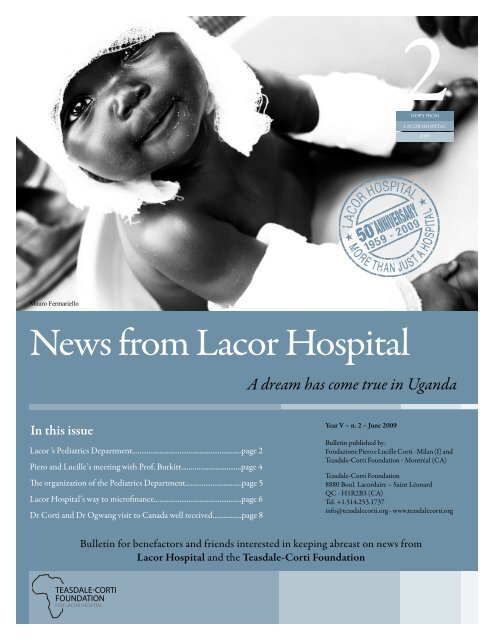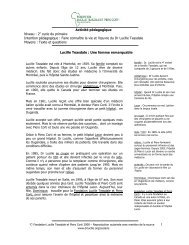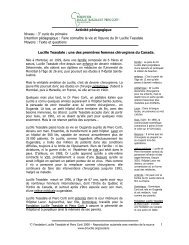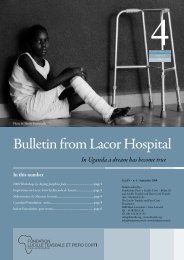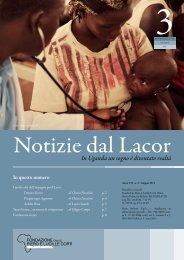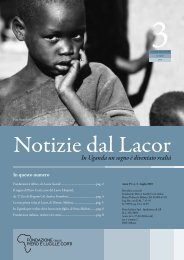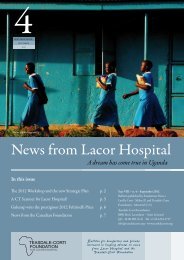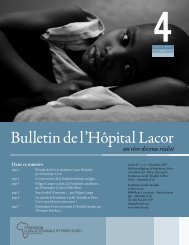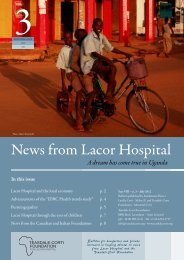A dream has come true in Uganda - Fondazione Corti
A dream has come true in Uganda - Fondazione Corti
A dream has come true in Uganda - Fondazione Corti
Create successful ePaper yourself
Turn your PDF publications into a flip-book with our unique Google optimized e-Paper software.
Mauro Fermariello<br />
News from Lacor Hospital<br />
In this issue<br />
Lacor ’s Pediatrics Department............................................................page 2<br />
Piero and Lucille’s meet<strong>in</strong>g with Prof. Burkitt................................page 4<br />
The organization of the Pediatrics Department...............................page 5<br />
Lacor Hospital’s way to microf<strong>in</strong>ance................................................page 6<br />
Dr <strong>Corti</strong> and Dr Ogwang visit to Canada well received................page 8<br />
2NEWS FROM<br />
LACOR HOSPITAL<br />
A <strong>dream</strong> <strong>has</strong> <strong>come</strong> <strong>true</strong> <strong>in</strong> <strong>Uganda</strong><br />
Year V – n. 2 – June 2009<br />
2009<br />
Bullet<strong>in</strong> published by:<br />
<strong>Fondazione</strong> Piero e Lucille <strong>Corti</strong> - Milan (I) and<br />
Teasdale-<strong>Corti</strong> Foundation - Montréal (CA)<br />
Teasdale-<strong>Corti</strong> Foundation<br />
8880 Boul. Lacordaire – Sa<strong>in</strong>t Léonard<br />
QC - H1R2B3 (CA)<br />
Tel. +1.514.253.1737<br />
<strong>in</strong>fo@teasdalecorti.org - www.teasdalecorti.org<br />
Bullet<strong>in</strong> for benefactors and friends <strong>in</strong>terested <strong>in</strong> keep<strong>in</strong>g abreast on news from<br />
Lacor Hospital and the Teasdale-<strong>Corti</strong> Foundation<br />
TEASDALE�CORTI<br />
FOUNDATION<br />
FOR LACOR HOSPITAL<br />
Photo by Mauro Fermariello
With 17,626 a d m i s s i o n s a n d 65,000 o u t p a t i e n t s p e r y e a r, t h e pe d i a t r i c s de p a r t m e n t<br />
is t h e Lac o r hos p i t aL ’s busiest o n e , d e a L i n g W i t h u p t o 400 p a t i e n t s e v e r y d a y d u r i n g t h e<br />
p e a k seasons (ma y-oc t o b e r ). so m e 59,958 a d d i t i o n aL c h iL d r e n a r e t r e a t e d <strong>in</strong> t h e ho s p it<br />
a L’s th r e e pe r i p h e r a L he a L t h ce n t e r s.<br />
Lacor’s Pediatric Department<br />
An <strong>in</strong>terview with Dr Nyeko Richard<br />
Lacor Hospital’s Pediatrics Department comprises a Children’s<br />
Ward, an Outpatient Department called the Young<br />
Child Cl<strong>in</strong>ic (YCC), a Nutrition Unit and an Isolation Unit,<br />
however there are plans to move the latter under the Department<br />
of Medic<strong>in</strong>e <strong>in</strong> the future. It also <strong>in</strong>cludes a small Neonatal<br />
Unit for premature babies which was set up very recently,<br />
and a unit for patients affected by Burkitts lymphoma (a<br />
childhood cancer endemic <strong>in</strong> equatorial Africa) admitt<strong>in</strong>g<br />
patients up to 17 years of age, while all other units <strong>in</strong> the Department<br />
admit only patients under 6 years of age. These represent<br />
38% of the hospital’s total number of contacts (<strong>in</strong>patients<br />
and outpatients) and get treatment totally for free,<br />
except for a token fee <strong>in</strong> the YCC. Pregnant mothers also get<br />
totally free treatment. This is how the hospital seeks to help<br />
families <strong>in</strong> a region where most people live below the poverty<br />
l<strong>in</strong>e.<br />
Dr Nyeko Richard, a qualified pediatrician and Head of the<br />
Department, expla<strong>in</strong>s that the major cause for admitt<strong>in</strong>g children<br />
under five to the Hospital is malaria (40% of all admissions,<br />
<strong>in</strong> l<strong>in</strong>e with the national rate). Accord<strong>in</strong>g to the WHO,<br />
every 30 seconds a child dies from malaria <strong>in</strong> Africa, caus<strong>in</strong>g<br />
a loss of 1.3% of annual economic growth <strong>in</strong> countries with<br />
<strong>in</strong>tense transmission and cutt<strong>in</strong>g attendance at school and at<br />
workplaces. The second most common cause of children’s ad-<br />
Bullet<strong>in</strong> from Lacor - page 2<br />
mission is <strong>in</strong>fection of the respiratory tract, <strong>in</strong>clud<strong>in</strong>g pneumonia,<br />
account<strong>in</strong>g for about 27% of all admissions and is followed<br />
by diarrheal diseases, anaemia (often a complication<br />
of malaria), malnutrition and septicemia, and then by other<br />
<strong>in</strong>fections and sk<strong>in</strong> diseases.<br />
Dr. Nyeko, what is the major cause of death <strong>in</strong> your department?<br />
Dr Nyeko Richard, Head of the Pediatric Department<br />
Surpris<strong>in</strong>gly, it is not malaria: our ma<strong>in</strong> cause of death is pneumonia,<br />
caus<strong>in</strong>g 18% of child mortality. Malaria, account<strong>in</strong>g<br />
for approximately 16% of deaths, is the second cause, followed<br />
by malnutrition and septicaemia. Our death rate <strong>in</strong> the<br />
last 6 years <strong>has</strong> ranged between 3 and 4 percent, tak<strong>in</strong>g <strong>in</strong>to<br />
account children admitted for severe acute malnutrition. But<br />
when you consider the general pediatric ward alone, it is less<br />
than 3%. Even at a national level, mortality for severe malnu-
trition is still very high. Many deaths occur with<strong>in</strong> the first<br />
24- 48 hours of admission and they are ma<strong>in</strong>ly referrals. The<br />
ma<strong>in</strong> issue for this department is late referral: patients simply<br />
arrive here late. Often the damage <strong>has</strong> already been done.<br />
Men<strong>in</strong>gitis, for example, often <strong>come</strong>s with complications. In<br />
our communities, people are not used to go<strong>in</strong>g to the hospital<br />
as soon as they discover they have a problem. They first go<br />
to their neighbours, or the traditional healer, and then to the<br />
drug shops… It’s only when they fail all these that they <strong>come</strong><br />
here.<br />
What are the most common treatments by the local traditional<br />
healers?<br />
We have many cases of “eb<strong>in</strong>o” and “tea-tea”. Eb<strong>in</strong>o is the extraction<br />
of the child’s unerupted can<strong>in</strong>e teeth, believed to cause<br />
such diseases as diarrhea, vomit<strong>in</strong>g and fever. Tea-tea is also<br />
very crude. They cut the child’s sk<strong>in</strong> deep on the chest walls or<br />
on the hands and feet, and claim to remove millet gra<strong>in</strong>s. Of<br />
course, these practices are not performed under sterile conditions,<br />
so cases of sepsis and <strong>in</strong>fections are frequent. We have<br />
been and are still fight<strong>in</strong>g these practices through educational<br />
activities <strong>in</strong> the villages, but they are very hard to eradicate.<br />
Lacor Hospital treats HIV-positive mothers with anti-retrovirals.<br />
What is the rate of mother-to-child transmission of the virus?<br />
I don’t have the exact figures but we still see a high number<br />
Mauro Fermariello<br />
of children <strong>in</strong>fected by way of vertical transmission. It is not<br />
only dur<strong>in</strong>g delivery that they get <strong>in</strong>fected, as breastfeed<strong>in</strong>g<br />
also <strong>in</strong>creases the risks of transmission, and our poor mothers<br />
can’t afford other k<strong>in</strong>ds of replacement feed<strong>in</strong>g. Another issue<br />
is hygiene: even when artificial milk is provided (through<br />
NGO-sponsored programs), it can never be guaranteed due<br />
to poor liv<strong>in</strong>g conditions <strong>in</strong> the villages. That is why these children<br />
often <strong>come</strong> back to us with diarrheal diseases and other<br />
<strong>in</strong>fections. Most of them may die before their first birthday.<br />
However, the hospital <strong>has</strong> a programme for prevent<strong>in</strong>g mother-to-child<br />
transmission of HIV <strong>in</strong>fection, which can reduce<br />
the risk many folds. Through this program, approximately<br />
500 pregnant mothers every year are treated with anti-retroviral<br />
therapy. Unfortunately, the follow up of mothers and<br />
children after the delivery is still a challenge, and as a result we<br />
cannot estimate the exact impact of this programme on our<br />
patients.<br />
Regard<strong>in</strong>g malnutrition, who is admitted to the unit?<br />
Bullet<strong>in</strong> from Lacor - page 3<br />
We admit patients with severe acute malnutrition, when the<br />
life of the child itself is threatened. These patients are managed<br />
<strong>in</strong> 2 p<strong>has</strong>es. P<strong>has</strong>e I is a stabilization p<strong>has</strong>e last<strong>in</strong>g 7 days on<br />
average. It ma<strong>in</strong>ly <strong>in</strong>volves treatment and prevention of complications<br />
and the patients are given special therapeutic milk<br />
called F75. Their weight is monitored constantly. Those with<br />
edema are expected to lose weight dur<strong>in</strong>g this p<strong>has</strong>e as they<br />
lose the excess fluids, before start<strong>in</strong>g to rega<strong>in</strong> weight. Transi-
PIERO AND LUCILLE’S MEETING WITH PROF. BURKITT<br />
Burkitt’s lymphoma was studied <strong>in</strong> <strong>Uganda</strong> and described for<br />
the first time by the surgeon who discovered it, Denis Parsons<br />
Burkitt, <strong>in</strong> 1958. It is the most common cancer of children <strong>in</strong><br />
equatorial Africa. When Piero and Lucille first arrived <strong>in</strong> <strong>Uganda</strong>,<br />
<strong>in</strong> 1961, they were lucky enough to personally meet Denis<br />
Burkitt who, at the time, was work<strong>in</strong>g at the Mulago university<br />
hospital to which they had been assigned for an <strong>in</strong>ternship<br />
that was supposed to last 1-3 months, and was mandatory for<br />
the <strong>in</strong>clusion of foreign doctors. After a short <strong>in</strong>terview, Professor<br />
Burkitt stated that both Piero and Lucille were eligible, thus<br />
exempt<strong>in</strong>g them from the mandatory <strong>in</strong>ternship.<br />
Quoted from the book “Un rêve pour la vie” by Michel Arseneault:<br />
“For years he had been obsessed by a strange disease, a mysterious malignancy<br />
that especially hit children aged 4–8. (....) He had begun to systematically<br />
photograph them and had noticed that the diseased children,<br />
with a jaw swell<strong>in</strong>g, sooner or later developed other cancers <strong>in</strong> the abdomen.<br />
(...) Lucille and Piero followed Burkitt <strong>in</strong> the operat<strong>in</strong>g theatre. (...) After the<br />
very simple surgery, Burkitt asked Lucille to describe how many operations<br />
she had carried out. From the beg<strong>in</strong>n<strong>in</strong>g of her <strong>in</strong>ternship, she expla<strong>in</strong>ed,<br />
she had carried out a few hundred operations, some highly complex, and<br />
had worked side by side with surgeons who had taught her avant-garde<br />
techniques. In particular, she had assisted Doctor Coll<strong>in</strong>, who had operated<br />
on an esophageal atresia, one of the first operations of that k<strong>in</strong>d<br />
tion is an <strong>in</strong>termediate p<strong>has</strong>e: the children’s absorbtion capacity<br />
<strong>has</strong> now <strong>in</strong>creased, so they are changed from F75 to F100,<br />
which <strong>has</strong> more calories, and are monitored for a few days.<br />
The children are then moved to p<strong>has</strong>e II, the rehabilitation<br />
p<strong>has</strong>e. They are now stable and able to eat food, so this is when<br />
we start them on nutricam, a special, balanced semi solid food<br />
made from local <strong>in</strong>gredients, and prepare them for discharge.<br />
It is essential that these children be fed very regularly. We have<br />
on average 40-60 of these patients per day <strong>in</strong> our unit. Dur<strong>in</strong>g<br />
the war times, they used to be more than 100. The mortality<br />
rate for these patients is about 7-10%.<br />
You also have a dedicated unit for Burkitt’s lymphoma. What<br />
k<strong>in</strong>d of lymphoma is it?<br />
The Burkitt’s lymphoma, which is endemic <strong>in</strong> this area, is the<br />
most common childhood cancer <strong>in</strong> Equatorial Africa and<br />
Bullet<strong>in</strong> from Lacor - page 4<br />
affects children much more than adults. It <strong>has</strong> a high chance<br />
of <strong>in</strong>volv<strong>in</strong>g the jawbone or the abdomen. It is a highly aggressive<br />
cancer, often life threaten<strong>in</strong>g but also one of the more curable<br />
forms of lymphoma. We generally admit approximately<br />
90 such patients per year and their number is steadily <strong>in</strong>creas<strong>in</strong>g.<br />
There is a high chance for a good out<strong>come</strong> of treatment,<br />
but the chemotherapy lasts 3 months, which is a long period if<br />
you consider the <strong>in</strong>direct costs of treatment (for patients and/<br />
<strong>in</strong> Canada, <strong>in</strong> 1956. The alimentary<br />
tract of a newborn baby had to be<br />
reconstructed. (...) Piero observed<br />
the scene. As he had already been<br />
able to often see, Lucille was not<br />
talk<strong>in</strong>g surgery, she was celebrat<strong>in</strong>g<br />
it! Her theoretical knowledge<br />
and practical experience could not<br />
be questioned. In addition, an unquestionable<br />
enthusiasm, sometimes<br />
<strong>in</strong>nocent but never naive.<br />
- Well - Lucille concluded – now you<br />
know the essential. This afternoon,<br />
what are we go<strong>in</strong>g to do? Burkitt’s<br />
answer came immediately.<br />
- Clearly, he told them, there’s no<br />
need for you to stay here. There’s<br />
no po<strong>in</strong>t <strong>in</strong> your watch<strong>in</strong>g me operate,<br />
when you have so much to<br />
do <strong>in</strong> the North. No, it’s better that<br />
you go up to Gulu. There they certa<strong>in</strong>ly<br />
need you”.<br />
This was the beg<strong>in</strong>n<strong>in</strong>g of Piero<br />
and Lucille’s long adventure<br />
at Lacor.<br />
A typical Burkitt’s case from the<br />
<strong>Corti</strong>s’ photo archive<br />
or their attendants who are unable to work dur<strong>in</strong>g hospitalization),<br />
so sometimes the patient fails to complete the cycle.<br />
What is your typical work<strong>in</strong>g day?<br />
A busy one. The ra<strong>in</strong>y season, beg<strong>in</strong>n<strong>in</strong>g <strong>in</strong> the end of April, is<br />
our peak season. It is when malaria strikes more: we can have<br />
on average over 400 <strong>in</strong>-patient contacts everyday. So the work<br />
is much.<br />
What are the challenges for your department?<br />
Well, we use very simple technology so our challenge is more<br />
on the staff<strong>in</strong>g side. We have many diagnostic facilities that<br />
other hospitals don’t have, so we attract many patients. As I<br />
said, our number of contacts is very high. In order to improve<br />
the quality of our service, I th<strong>in</strong>k we need an optimal balance<br />
between patients and personnel. And we need tra<strong>in</strong><strong>in</strong>g. The<br />
world is mov<strong>in</strong>g fast and medic<strong>in</strong>e is chang<strong>in</strong>g fast, therefore<br />
we would need people to specialize <strong>in</strong> areas such as pediatric<br />
<strong>in</strong>tensive care, neonatology and others.<br />
Chiara Paccaloni
g<br />
THE ORGANIZATION OF THE PEDIATRICS DEPARTMENT<br />
Lacor Hospital, together with the 3 Health Centres built <strong>in</strong><br />
peripheral areas of Lacor, serves a large geographical area<br />
<strong>in</strong> Northern <strong>Uganda</strong> with a population of more than half a<br />
million people. Be<strong>in</strong>g the reference hospital, it also receives<br />
patients from as far away as Sudan. In 2008, children aged<br />
under 5 accounted for 56% of the total number of <strong>in</strong>patients<br />
<strong>in</strong> the hospital. Every day on average 300 children reach the<br />
pediatrics outpatients department (Young Child Cl<strong>in</strong>ic - YCC),<br />
which is not surpris<strong>in</strong>g when we consider that the exam<strong>in</strong>ation<br />
and drugs cost less than 40 Euro cents. Admission is free<br />
of charge.<br />
The Pediatrics Department consists of:<br />
- A general Children Ward, divided by sectors-diseases<br />
(emergency, day-hospital, malaria, cancer, pneumonia,<br />
diarrhea, anemia, neo-natal). There are 106 beds, with a<br />
bed occupancy rate of more than 150% (2008). This means<br />
that a third of the children must sleep on mats, just as<br />
they do at home, because there are not enough beds for<br />
everybody;<br />
- Serious Malnutrition Unit (40 beds, 716 admissions <strong>in</strong><br />
2008), divided <strong>in</strong>to sectors accord<strong>in</strong>g to disease seriousness<br />
(<strong>in</strong>tensive, <strong>in</strong>termediate and pre-release nutrition treatment);<br />
- Isolation Unit for contagious cases (20 beds);<br />
- Neonatal Unit for premature children, with 10 small beds<br />
<strong>in</strong> a solar heated room (recently built);<br />
- HIV-AIDS Cl<strong>in</strong>ics (203 children under treatment as per today)<br />
and for sickle cell anemia (newly established).<br />
Children with serious surgical diseases are ‘concentrated’ <strong>in</strong><br />
specific times of the year when surgery is performed by teams<br />
of pediatric surgeons com<strong>in</strong>g from abroad. A vacc<strong>in</strong>ation<br />
service is guaranteed to all children (<strong>in</strong> and out patients)<br />
that <strong>come</strong> to the hospital: if necessary, the child is vacc<strong>in</strong>ated<br />
before go<strong>in</strong>g back home.<br />
There were 4,465 deliveries <strong>in</strong> 2008: these babies were exam<strong>in</strong>ed<br />
before release. Of them, 500 were born from HIV positive<br />
mothers and were given preventive treatment aga<strong>in</strong>st<br />
the vertical transmission of the HIV virus. These are figures of<br />
a large children’s hospital; these are the classic diseases of an<br />
African hospital with the addition of complex cases referred<br />
from other hospitals. Malaria is the first reason for admission,<br />
followed by lung diseases and malnutrition. The overall mortality<br />
<strong>in</strong> the department <strong>in</strong> 2008 was 4%.<br />
A hospital is a reliable observatory of the general situation of<br />
the area’s population. Mothers and children com<strong>in</strong>g to Lacor<br />
Hospital show signs of great poverty and overall difficulty.<br />
Malnourished children did not exist before the war, yet they<br />
cont<strong>in</strong>ue to be admitted <strong>in</strong> the Gulu district, often as term<strong>in</strong>al<br />
patients: more than 7% of them die <strong>in</strong> the ward. We can<br />
estimate that for each malnourished child admitted, at least<br />
2 more are left beh<strong>in</strong>d and die at home. Besides, children’s<br />
poor general nutrition affects their defense aga<strong>in</strong>st <strong>in</strong>fectious<br />
diseases, which means they can even die from ord<strong>in</strong>ary diarrhea;<br />
mothers’ malnutrition implies that many children are<br />
born with low weight and/or prematurely. Global health va-<br />
lues (<strong>in</strong>dicators) <strong>in</strong> the Gulu district show a clear difference<br />
with those of the Nation: for every 1,000 children born, 149<br />
die with<strong>in</strong> their first 12 months, compared to “only” 88 <strong>in</strong> the<br />
rest of the Country, life expectancy at birth is 40.9 years <strong>in</strong><br />
Gulu and 48.1 <strong>in</strong> the rest of the Country.<br />
Mauro Fermariello<br />
One must be aware that disease treatment <strong>in</strong> a child is the<br />
last r<strong>in</strong>g <strong>in</strong> a cha<strong>in</strong> with prevention among its other r<strong>in</strong>gs.<br />
The global service provided by the hospital’s health centers<br />
is methodic and without <strong>in</strong>terruptions and <strong>in</strong>cludes vacc<strong>in</strong>ations,<br />
monthly weight check, healthcare and nutrition education,<br />
identification of children at risk, promotion of treated<br />
mosquito nets, adm<strong>in</strong>istration of Vitam<strong>in</strong> A every six months,<br />
worm dis<strong>in</strong>festation. Mothers are also encouraged to deliver<br />
<strong>in</strong> a safe environment, with the help of a professional, not at<br />
home. This reduces maternal and newborn mortality. Morbidity<br />
and mortality figures of the hospital are regularly transmitted<br />
to the District Health authorities. Prevention will then<br />
rely on the analysis and assessment of these figures <strong>in</strong> order<br />
to act <strong>in</strong> a targeted way at the level of the health centres.<br />
The value of treat<strong>in</strong>g ill children goes beyond the mere survival<br />
of a patient. The most precious wealth of a poor family<br />
is represented by its children, and little else. Offer<strong>in</strong>g a child<br />
treatment service (offer<strong>in</strong>g it <strong>in</strong> a way which is appropriate,<br />
professional, human and free-of-charge) means act<strong>in</strong>g where<br />
the need for help is more widely felt and requested. It means<br />
dissem<strong>in</strong>at<strong>in</strong>g a sense of normality among a population<br />
afflicted by years of conflict. It also means peace, social justice,<br />
development.<br />
The disease of a child is part of the possible events <strong>in</strong> the life<br />
of a family and death cannot always be avoided. Assist<strong>in</strong>g a<br />
dy<strong>in</strong>g child is however possible and necessary, as necessary is<br />
sympathiz<strong>in</strong>g with their parents, reliev<strong>in</strong>g their anxiety, be<strong>in</strong>g
there at the moment of death. A doctor absorbs this “marg<strong>in</strong>al”<br />
aspect of treatment from the surround<strong>in</strong>g environment,<br />
<strong>in</strong> particular from the behaviour of nurses (of local language<br />
and culture): Lacor’s nurses, tra<strong>in</strong>ed with<strong>in</strong> the hospital,<br />
know how to comb<strong>in</strong>e professionalism with natural skills of<br />
empathy, sensitivity and understand<strong>in</strong>g. True, they are also<br />
mothers themselves …<br />
The operation of a s<strong>in</strong>gle department and the quality level of<br />
care given to patients depend on the constant presence of<br />
appropriate every-day use tools (from syr<strong>in</strong>ges to catheters, all<br />
disposable), of even expensive yet necessary mach<strong>in</strong>es (such<br />
as, for example, oxygen concentrators), of drugs (the most<br />
effective, from antibiotics to anticancer drugs), of adequate<br />
nurs<strong>in</strong>g staff. If you have all this, you manage to provide adequate<br />
services and save human lives. All those ancillary services<br />
must be added to these resources which allow or confirm<br />
a diagnosis (radiology, laboratory, bacteriology, endoscopic<br />
<strong>in</strong>vestigantion, bioptic exam<strong>in</strong>ations) and those which ensure<br />
more advanced treatment (pediatric surgery, island for<br />
premature babies, <strong>in</strong>tensive care, specialist cl<strong>in</strong>ics). St. Mary’s<br />
Hospital guarantees all these services, with rare <strong>in</strong>terruptions<br />
<strong>in</strong> the availability of drugs and/or consumables. All this gives<br />
the opportunity to work well, to be effective. The only “drawback”<br />
would be patient overcrowd<strong>in</strong>g: noth<strong>in</strong>g like good healthcare<br />
performance conv<strong>in</strong>ces people to use it.<br />
The Pediatrics Department of Lacor belongs to children and<br />
Mauro Fermariello<br />
mothers: there are no limitations <strong>in</strong> terms of space, time or<br />
requests. At night the floor be<strong>come</strong>s a huge dorm, to move<br />
where you must step beyond the bodies of mothers and<br />
children. They sleep on mats, a dish of food “appears” from<br />
nowhere, it is always surpris<strong>in</strong>g to see how they can deal<br />
with the difficulty of be<strong>in</strong>g <strong>in</strong> a shelter away from home, nearly<br />
always with little money, lack of communication, often<br />
accompanied by another child <strong>in</strong> addition to the one who is<br />
ill. Yet it all happens <strong>in</strong> serenity and extreme dignity. Once the<br />
children are better, they rush as they wish <strong>in</strong> the large area <strong>in</strong><br />
front of the wards: observ<strong>in</strong>g their livel<strong>in</strong>ess, joy and trust is<br />
the reward for the effort made for their health.<br />
Massimo Serventi, pediatrician<br />
It takes us only 13$ to treat a patient<br />
In Ug a n d a, m o s t people l Iv e o n less t h a n 1 dollar per d a y. WIth a n e m p l o y m e n t r a t e o f 3.2%, t h o s e W h o<br />
h a v e a s a l a r y c a n p r o v Id e f o r t h e needs o f a f a m Il y, generally m a d e U p o f 10/15 p e r s o n s, b U t t h e n t h e m o n e y<br />
Is totally s p e n t o n f o o d. ho W t h e h o s p It a l h e l p s Its Workers h a v e access to e d U c a t Io n, h o U s In g, f a r m In g.<br />
Lacor Hospital’s way to microf<strong>in</strong>ance<br />
The Hospital’s loan cooperative<br />
“The cost of liv<strong>in</strong>g <strong>has</strong> doubled <strong>in</strong> <strong>Uganda</strong> <strong>in</strong> the last 7 years<br />
and this trend doesn’t seem likely to decrease”. This is why<br />
Nyeko-Rac Thomas, Health Educator at the Lacor Hospital,<br />
decided to jo<strong>in</strong> the Hospital workers’ loan cooperative.<br />
He became a member five years ago and <strong>has</strong> so far benefited<br />
from five loans. Until this year, he <strong>has</strong> used them to pay for<br />
his children’s school fees (he <strong>has</strong> three of his own and two<br />
“adopted”). “My older daughter, who is 15, is especially fond<br />
of school. She likes it a lot. When it seems there could be not<br />
enough money to pay for the fees, she pulls a long face…” The<br />
problem with school fees is that they have to be paid with a<br />
three-month advance, otherwise the student must stop attend<strong>in</strong>g<br />
school, an unfortunate and quite shameful experience<br />
for both the kids and their family. For the moment Nyeko-<br />
Rac Thomas <strong>has</strong> always succeeded <strong>in</strong> keep<strong>in</strong>g his children <strong>in</strong><br />
school. Besides, this year the loans have also allowed him to<br />
buy a small plot of land, <strong>in</strong> Lacor, the nearest village to the hospital.<br />
The price was quite high, approximately US$460, due<br />
to land’s position, a mere 50 m away from the village center.<br />
He also plans to have his own house built there, <strong>in</strong> 5 years’
Mauro Fermariello<br />
time. He <strong>has</strong> already designed it: 90 sq. m, three bedrooms,<br />
a sitt<strong>in</strong>g room, a bathroom and a store. The kitchen will be<br />
built outside and it will also serve as an additional room. He<br />
is also already build<strong>in</strong>g a hut for his guests, with the help of<br />
Brother Elio’s workers, from the Technical Department. Accord<strong>in</strong>g<br />
to his estimate, the cost of the house will be on the<br />
whole approximately 10 million shill<strong>in</strong>gs (US$5,000). Add to<br />
that the cost for the hut (about US$270) and the land itself<br />
(almost 1 million Shs), the expenses are high and could not<br />
be afforded without external f<strong>in</strong>ancial support. The hospital’s<br />
zero-<strong>in</strong>terest rate loan cooperative was founded <strong>in</strong> 1997 with<br />
the help of the Italian Cooperation which donated start-up<br />
funds of 123 million shill<strong>in</strong>gs. The hospital also lent further<br />
135 million. The aim of the cooperative is to support its junior<br />
employees, with low salaries, <strong>in</strong> fac<strong>in</strong>g necessary expenses. Mr<br />
Otema Francis Kitara, treasurer of the cooperative s<strong>in</strong>ce 2006,<br />
expla<strong>in</strong>s that, by statute, money can be lent only to f<strong>in</strong>ance<br />
school fees and the acquisition of land for farm<strong>in</strong>g or build<strong>in</strong>g<br />
one’s house. “Further needs can also be f<strong>in</strong>anced as an<br />
exception, <strong>in</strong> case for example someone is sick and can only<br />
be treated <strong>in</strong> another hospital (if they could get treatment <strong>in</strong><br />
Lacor then it would be free) and the cares needed are very ex-<br />
The payment of<br />
school fees is one<br />
of the ma<strong>in</strong> reasons<br />
why Lacor Hospital’s<br />
workers jo<strong>in</strong> its loan<br />
cooperative<br />
pensive.<br />
Provid<strong>in</strong>g <strong>in</strong>terest-free loans, the cooperative <strong>has</strong> an yearly<br />
loss due to high <strong>in</strong>flation and to some sporadic cases where<br />
the person <strong>has</strong> not been able to pay back (ma<strong>in</strong>ly due to<br />
death or more rarely to deliberate <strong>in</strong>solvency). This is why<br />
the hospital keeps <strong>in</strong>ject<strong>in</strong>g capital once <strong>in</strong> a while, but the<br />
cooperative represents an <strong>in</strong>direct advantage for Lacor s<strong>in</strong>ce<br />
such a benefit is a strong means to fidelize its employees.<br />
The loans are paid back <strong>in</strong> up to 2-3 years, through the help of<br />
the Hospital which directly withholds the monthly amount<br />
from payroll and gives it back to the cooperative. Loan<br />
amounts are decided on the basis of the member’s household<br />
<strong>in</strong><strong>come</strong>: the monthly reimbursement must not exceed one<br />
third of the salary. As per today, 398 workers are benefit<strong>in</strong>g<br />
from its loans and there have been 600 s<strong>in</strong>ce the beg<strong>in</strong>n<strong>in</strong>g<br />
Bullet<strong>in</strong> from Lacor - page 7<br />
of its activity. The entry fee is 45,000 Shs (about US$20). In<br />
11 years, the loans issued have amounted to 1,760,073,500Shs<br />
(about US$ 902,602).<br />
“Nyeko-Rac” means “envy is bad”. And quite curiously,<br />
Nyeko-Rac Thomas doesn’t seem affected by envy <strong>in</strong> any way.<br />
Maybe it’s because he <strong>has</strong> found a way to face his family’s essential<br />
needs.<br />
Chiara Paccaloni
DR. DOMINIQUE CORTI AND DR. MARTIN OGWANG VI-<br />
SIT TO CANADA WELL RECEIVED<br />
Dr. <strong>Corti</strong> was among well known participants at the Montreal<br />
Millennium Summit, featur<strong>in</strong>g also Iranian Nobel<br />
Peace prize w<strong>in</strong>ner Dr. Shir<strong>in</strong> Ebadi, the Governor General<br />
of Canada Michaëlle Jean, economist Jeffrey D. Sachs,<br />
actress Mia Farrow and the Duchess of York Sara Ferguson.<br />
Thanks to the <strong>in</strong>itiative of Daniel Germa<strong>in</strong> the Summit<br />
united <strong>in</strong>ternational speakers and activists to discuss and<br />
exchange ideas on human development, poverty, health<br />
and solidarity.<br />
The Lacor Hospital was at the heart of the Summit and<br />
awareness was raised to the cause. “With only 13$, we<br />
can treat one person” was Dom<strong>in</strong>ique’s personal message<br />
to the public. Mak<strong>in</strong>g it clear that it takes one step at<br />
a time to reach our goals. The presentation was received<br />
with a warm stand<strong>in</strong>g ovation.<br />
The photography exhibition Lacor Hospital: An African<br />
Success Story, was displayed at the Summit and created<br />
quite a stir. The 60 images taken by well known Italian<br />
photographer, Mauro Fermariello, show the Lacor Hospital<br />
and its context <strong>in</strong> northern <strong>Uganda</strong>. “Orig<strong>in</strong>ally operated<br />
by a few Italian missionaries, we now have on staff<br />
almost 600 <strong>Uganda</strong>ns”, quoted Dr. Mart<strong>in</strong>. Close to 3,000<br />
guests were present at the Summit and all had an opportunity<br />
of view<strong>in</strong>g the exhibition on what <strong>has</strong> grown <strong>in</strong>to<br />
one of the best non-profit medical centres <strong>in</strong> equatorial<br />
Africa. The exhibition is proof of the hospital’s legacy of<br />
empowerment and helped create more awareness of Lacor’s<br />
work.<br />
Dr. <strong>Corti</strong> along with Dr. Ogwang, the <strong>in</strong>stitutional director<br />
of Lacor Hospital, then made their way to the University of<br />
Toronto for the 7th Annual Global Health Research Conference:<br />
Convergence of Maternal and Child Health organized<br />
by Judy Kopelow of the Centre for International Health,<br />
Dala Lana School of Public Health. The Lacor Hospital<br />
Bullet<strong>in</strong> from Lacor Hospital - page 8<br />
THE TEAsdALE-CorTI FoundATIon<br />
The Teasdale-<strong>Corti</strong> Foundation is a charitable organization<br />
created to contribute to the support of the Lacor<br />
Hospital <strong>in</strong> northern <strong>Uganda</strong>.<br />
Reg. N. : 890520745RR 0001<br />
rEFErEnCE<br />
Filippo Campo - f.campo@teasdalecorti.org<br />
Tel.: +1.514.253.1737<br />
8880, boul. Lacordaire, St-Léonard, QC.<br />
H1R 2B3 (CA)<br />
was showcased at the Conference Open<strong>in</strong>g Reception<br />
and Dr. Ogwang was also speaker <strong>in</strong> a panel on per<strong>in</strong>atal<br />
morbidity and mortality.<br />
Saundra Diardichuk<br />
Dom<strong>in</strong>ique <strong>Corti</strong> at the Summit <strong>in</strong> Montreal<br />
Dr. Mart<strong>in</strong> Ogwang, Dom<strong>in</strong>ique <strong>Corti</strong> and Filippo Campo (Teasdale-<br />
<strong>Corti</strong> Foundation) at the Millennium Summit <strong>in</strong> Montreal<br />
donATIons<br />
Donations to the Teasdale-<strong>Corti</strong> Foundation can be sent<br />
by mail to:<br />
8880, boul. Lacordaire, St-Léonard,<br />
QC, H1R 2B3 (CA)<br />
or onl<strong>in</strong>e: www.teasdalecorti.org<br />
nEws From LACor<br />
is a bullet<strong>in</strong> offered to all who wish to receive news on the<br />
Lacor Hospital and the Teasdale-<strong>Corti</strong> Foundation. It is<br />
published by <strong>Fondazione</strong> Piero e Lucille <strong>Corti</strong> (Milan,<br />
Italy) and Teasdale-<strong>Corti</strong> Foundation (Montreal, Canada).


